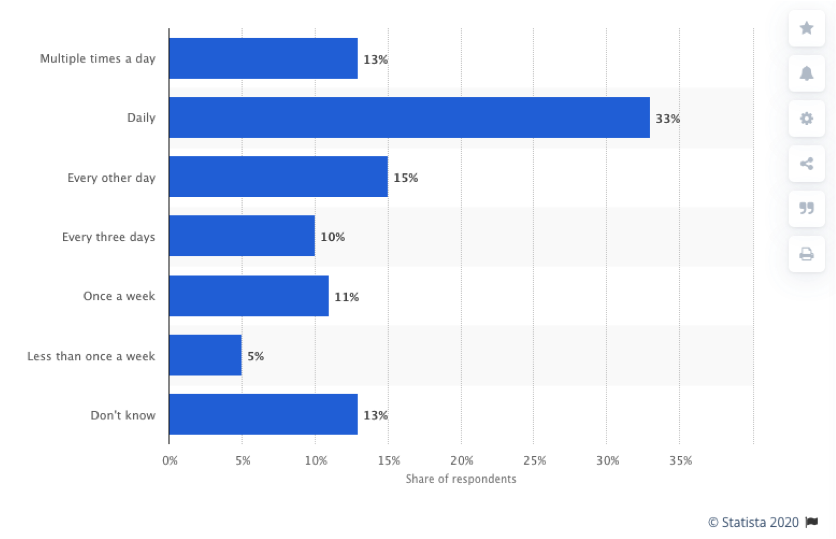As social media consumption continues to grow and shape consumer choices, more brands are turning to influencer marketing to draw in new customers. The pandemic has further accelerated this trend as cooped-up consumers increased social media usage by up to 63%. As a result, social media influencer marketing investments are witnessing an uptick. With an estimated 50% YoY increase in market size, the influencer marketing industry is all set to reach USD 10 billion by the end of 2020. But not all’s fine and dandy. As more social media users look to profit from influencer marketing, rampant “buying” of followers and likes to fake engagement and social proof is hurting businesses both big and small.
Research from cyber security firm, Cheq, shows that at least 15% of advertisers’ spending on influencer marketing is lost to fraud, costing them up to USD 1.3 billion annually. With engagement considered the top success metric for influencer campaigns, many influencers are resorting to apps that offer paid followers, likes and even comments for under a dollar. Such unethical practices has made it increasingly tough for businesses to reap positive ROI from their influencer marketing spend.
What steps can advertisers take to identify genuine influencers and gain measurable brand impact from their influencer marketing efforts? Here are some key aspects to bear in mind:
Follower-to-engagement ratios
Be wary of ‘influencers’ with many followers and low engagement rates, i.e. likes, comments, and shares. Too many followers with very little engagement indicates poor content engagement and fake followers, while high engagement with very few followers indicates suspicious bot activity or purchased likes and comments.
Genuine influencers will have high follower as well as engagement rates, and, more often than not, have a larger following base than the accounts they follow. A quality influencer sees a minimum engagement rate of about 2-3%. So an influencer with 1 million followers should garner a minimum of 20,000 to 30,000 interactions in the form of likes, shares, or comments.
Below 1% and over 10% engagement should be a cause for suspicion, indicating poor content engagement and disinterest or artificial engagement techniques. The most important metric to determine the worth of an online creator is to study user engagement. This can be measured by taking an average across ten latest posts and dividing it by the number of followers using relevant agency tools such as KeyHole, SocialBlade, Traackr and HypeAuditor.
It’s vital for brands to measure user posts and analyze engagement patterns to gauge influencer and account authenticity. Moreover, professional influencers take follower interaction and feedback very seriously. They’ll usually interact with them and build on such feedback to develop and expand their target audience further.
Frequency of posting
Another thing to watch out for in suspicious profiles is the frequency in the user’s posting. Too many followers with very little posts and a dormant or nearly inactive account is a cause for concern. Genuine accounts will see consistency in posting content and have a relatively steady upward growth rate in their number of followers. Once there’s increased publicity and recognition, their growth rate may substantially increase, but there won’t be a sudden sporadic increment. Studies show that optimal posting frequency, while differs with platforms, is at least one or two posts per day. Statista’s online survey conducted in 2019, shows how often users prefer social media influencers to post. Around 13% of the respondents stated that they want influencers to post multiple times a day.
How often do consumers want social media influencers to post content?

Measure influencer ROI using coupon codes
Often, influencers endorsing a certain brand or advertising a product, offer special discount coupon codes to encourage their followers to buy the product. These online content creators usually then charge the companies a flat fee or are offered a percentage of the sales generated, or sometimes even both. This usually is an indicator of an authentic fan base and encourages trust. It’s also a great way to measure the direct impact of the collaboration on revenues.
As a potential investor, it is essential that you crosscheck these coupon codes and track engagement to study buyer patterns and influencer authenticity. Consumers often tend to have attested to the validity of these coupons and backed the influencer through tags, mentions, and posts. Reiteration of these codes and reposts by the brand discourage fraudulent coupon offers and scams. Look out for transparency in influencer communication with their follower base. This will help gauge their credibility.
Review follower profiles
Carefully reviewing follower profiles and studying the quality of content will offer insights into what you can expect from a potential engagement. The norm has been to seek quantity of followers and likes over engagement and actual impact. This has created a black market called “click farms” that offer fake followers for a price, boost the number of likes, and post random auto-generated comments.
Accounts with minimal or dummy activity are specifically created for those that buy likes & followers. Often, bot accounts are created to follow thousands of people on the same day, simply to garner follow backs. Once sufficient people have been followed, it will rely on people not noticing to unfollow the fake account.
Dummy accounts solely created as a fake following account for other accounts will have no bio, hardly any followers, and almost no posts. Further, an overall check on follower profiles will also help ascertain influencer authenticity and identify if any followers on the influencer’s page offer buying services.
Use influencer monitoring tools
Adding a technological layer to your influencer vetting will provide measurable results and help make confident investments. While manual cross-referencing is critical, a slew of AI-based tools like BotSight, BotSlayer, etc. and platforms like Socialbakers, HypeAuditor, and countless others can help you identify and filter through fake followers, bot accounts, and misinformation. By analyzing click-through rates, affiliate links, coupon codes, user bio descriptions, and numerous other metrics to derive patterns, AI is proving instrumental in identifying and getting rid of fake engagement.
Influencer marketing, when done right, can boost brand awareness and revenues. In fact, it can yield up to 11x more ROI than traditional forms of marketing. But without an effective influencer tracking and measurement mechanism in place, you are likely to fall victim to influencer fraud.
Netscribes helps brands yield greater returns from their influencer marketing spend by employing robust social media monitoring and analytics. Some of the leading digital-first brands rely on Netscribes’ social media intelligence expertise to collaborate with the right influencers, measure engagement and ROI, and understand their consumers at a deeper level.
To find out how you can optimize your influencer marketing initiatives to maximize impact, connect with us at info@netscribes.com






